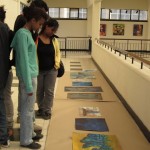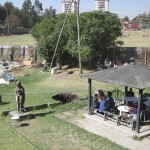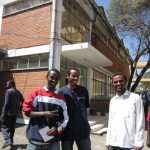Addis Ababa University is located in the heart of the city off the main boulevard in the former palace of Emperor Haile Selassie. Students roam the campus with backpacks in an assortment of universal student attire from the uniform blue jeans and tee-shirts to traditional Ethiopian dress of infinite color and variety.
With limited dormitory space, students who live in Addis must commute to make room for students coming from remote regions, but new dormitories are being built which will allow for more students to live on campus.
The Institute for Ethiopian Studies is located on the campus, with the Ethnographic Museum collection of cultural and religious art and artifacts. The John F. Kennedy Memorial Library is named in honor of the American President whose inauguration was attended by Haile Selassie. Robert Kennedy attended the groundbreaking, and their mother attended the dedication, after losing her second son.
The School of Fine Arts is located on a separate campus and has numerous buildings surrounding a central green and sculpture park with gardens. The school’s main building was built during the 1950s with bright light for artists’ studios and a two storey atrium designed for student art exhibition. While I was there, senior students had laid out their portfolios as their senior project for critique.
We dipped into some classrooms and observed a computer class underway with a series of older macs. A new dormitory is going up adjacent to the campus which will allow students to reside at school.
My lecture was presented in a drawing and painting studio. I presented a slide talk about Norman Rockwell to a group of about 50 students. While there, I had the serendipitous good fortune to meet artist and professor, Achamyeleh Debela, an Ethiopian American artist who had recently been in Raleigh, North Carolina and spoken on a panel about Norman Rockwell’s paintings of the Civil Rights movement at the North Carolina Museum of Art where our exhibition, American Chronicles: The Art of Norman Rockwell is on view. It was startlingly to realize that he had been with our Museum collection more recently that I have! Such is the intersection of the international Ethiopian/American arts leadership in Addis Ababa with the United States.
Upon conclusion of my talk, their professor addressed the students to remind them of the importance of their calling and commitment as artists, to be chroniclers of their culture and country. Later, students Teklemariam Tilahun, Yonatem Word Wosen, Nigath Solomon, Yetneberke Sebrike and Leykun Wondigraw, joined us for lunch at the US Embassy – they were volunteer interns to assist me with the hanging of the Four Freedoms exhibitions. (My apologies for any misspellings of names.)
I presented some books on illustration artists Wendell Minor, Jerry Pinkney and Norman Rockwell to Director Bekele for the art library of the School. When I asked the students where they obtained their art supplies, I learned that there is only one chemist in Addis Ababa who makes the oil paints that artists purchase for making their art. The concept of such scarcity of resources is a humble reminder of the abundance we enjoy in the United States.
I was reminded, too, of the universal passion and calling of artists to express their ideas and visions through art. I was pleased to see the connections between the United States and Ethiopian Diaspora – there is deep commitment upon the part of senior arts professors and artists to educate and inspire the next generation of artists.





